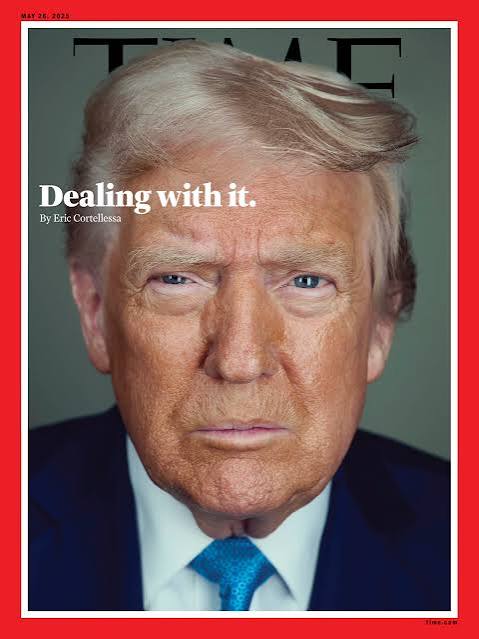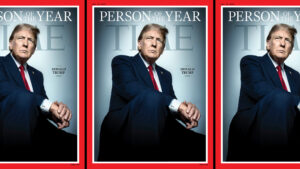New Time magazine cover Trump: Trump 100 days,attack on Trump,Staged

The self-proclaimed mission of Trump and his top aides in his first 100 days. Today we will discuss about New Time magazine cover Trump: Trump 100 days,attack on Trump,Staged
New Time magazine cover Trump: Trump 100 days,attack on Trump,Staged
In April 2025, Time magazine released a new cover featuring former U.S. President Donald Trump, marking his first 100 days in his second term. The cover instantly went viral — not because of its content alone, but due to the fierce debate surrounding it. Critics called it a “staged attack,” Trump supporters labeled it “biased,” while media analysts saw it as a fascinating case study of modern political image-making.
The cover, accompanied by a long-form interview, was meant to be a journalistic reflection on Trump’s return to power and his political direction during his first 100 days. However, it soon became a lightning rod for controversy — a cultural and political flashpoint that raised important questions about how media, politics, and image intertwine in today’s world.
This article dives deep into the Time magazine cover, exploring the story behind it, Trump’s reaction, the media framing, and why many called it “staged.”
1. The Context: Trump’s 100 Days Return to Spotlight

For any U.S. president, the first 100 days in office are symbolically powerful. They represent the first test of leadership, a period where the public, markets, and media assess the direction of the administration. For Trump, returning to the White House after a historic comeback, this milestone was more than a checkpoint — it was a statement.
Time magazine capitalized on the moment by granting Trump an extensive interview, covering his early policies, global strategies, and his renewed vision of American dominance. The cover line read something along the lines of “Trump’s First 100 Days: Back in Command”, but it was the image — not the text — that stole the spotlight.
The photo depicted Trump in a bold, close-up pose. His face was partially shadowed, his expression unreadable — somewhere between defiance and fatigue. It was visually dramatic, almost cinematic. But to Trump and his supporters, it appeared deliberately unflattering.
2. The Cover Image: Bold or Biased?
Every Time magazine cover is carefully curated, but this one sparked accusations of manipulation. The photograph, taken by renowned portrait photographer Martin Schoeller, featured Trump from a low angle, emphasizing his facial lines and deep shadows around his eyes.
Supporters saw this as a deliberate editorial decision — a visual statement designed to make Trump look authoritarian, tired, or even grotesque. Others argued it was merely artistic realism — showing Trump as he is: human, aged, but still commanding.
The debate intensified when Trump himself publicly criticized the cover. On his social media platform, he said the magazine “used the worst picture of all time,” accusing Time of intentionally trying to humiliate him. He even joked that the photographer “must have been standing in a hole” to shoot from such an unflattering angle.
This isn’t the first time Trump has clashed with media imagery. Throughout his career, he’s been extremely sensitive to how he’s portrayed — from television lighting to newspaper covers. His reaction fit a familiar pattern: criticize, discredit, and dominate the media cycle.
3. Trump’s Reaction: Turning Outrage into Opportunity
Trump’s outrage was immediate — but strategic. Within hours of the cover’s release, he posted multiple comments ridiculing the photo while ironically praising the article itself for being “relatively fair.”
By attacking the image, Trump reframed the public conversation. Instead of readers focusing on the Time article’s assessment of his early policies, they focused on the perceived unfairness of the cover photo.
This is a classic Trump tactic — transforming potential media damage into a populist rallying point. His base quickly took to social media to echo his sentiment, calling the photo “disrespectful,” “doctored,” or “an intentional hit piece.”
Ironically, this backlash made the cover even more famous. What might have been a typical anniversary issue became a cultural moment — proof, once again, that Trump understands media cycles better than most of his critics.
4. Inside the Story: What Time Magazine Reported
Beyond the cover image, the Time feature itself explored several key themes in Trump’s second-term agenda.
-
Trade Policy: Trump outlined a temporary suspension of tariffs for 90 days to stabilize financial markets. The move was framed as pragmatic flexibility, though critics said it revealed how market pressure still dictates his decisions.
-
Foreign Policy: Trump reaffirmed his tough stance on China and hinted at bold, unconventional strategies for territorial and trade expansion. Some statements — like talk of U.S. control over foreign assets — blurred the line between geopolitical vision and political theater.
-
Domestic Agenda: The article emphasized Trump’s renewed focus on infrastructure, border control, and economic growth. He claimed early victories but offered limited data to support them.
-
White House Dynamics: The interview subtly revealed internal friction within his administration — staffing issues, chain-of-command confusion, and Trump’s preference for direct control over decision-making.
While Time maintained a neutral editorial tone, the visuals and framing gave the story an air of tension — portraying Trump as powerful yet embattled, confident yet defiant.
5. “Staged” — The Critics’ Interpretation
The word “staged” began appearing across social media and political commentary shortly after the issue dropped. Some used it to describe the cover photo itself; others applied it to the broader Time–Trump dynamic.
There are two main interpretations of what “staged” means here:
A. The Staged Image: Critics claimed the photo shoot was intentionally designed to provoke Trump’s reaction. By presenting him in a way that seemed exaggeratedly dramatic — emphasizing wrinkles, lighting contrasts, and shadows — Time ensured a viral reaction.
B. The Staged Narrative: Others argue the entire feature was a performance. Trump granted access knowing Time would amplify his presence, while Time knew that his inevitable backlash would fuel their publicity. Both sides benefited — the magazine gained clicks and sales, Trump reinforced his “media victim” narrative.
In that sense, the controversy was not accidental — it was mutual theater, a carefully choreographed media dance that each side knows by heart.
6. Media Optics and Symbolism
Media theorists have long studied how visuals shape public perception more than words. The Time cover is a textbook case.
The framing of Trump — centered, direct, but shadowed — creates a psychological tension. It suggests dominance yet isolation. The close-up is intimate, yet uncomfortable. Even without reading the article, viewers interpret meaning: power, ego, fatigue, defiance.
Such semiotic choices are never random. Editors know that imagery becomes shorthand for meaning. A cover photo that feels “off” can imply moral ambiguity or controversy. For Trump supporters, this reads as bias. For critics, it signals realism.
This blurring of objectivity and artistry is what makes political imagery so potent — and dangerous. Every shadow and highlight can imply a judgment.
7. The Broader Media Landscape
The Time controversy also reveals how legacy media now functions in a hyper-digital world.
Once, magazine covers were consumed quietly at newsstands or coffee tables. Today, they’re content objects — optimized for social media, memes, and online debate. A controversial cover guarantees shares, outrage, and trending hashtags.
In this environment, controversy becomes part of the marketing plan. Time’s editors surely anticipated Trump’s reaction, knowing it would amplify attention. Trump, in turn, knew that by attacking the magazine, he could reclaim narrative control and rally his base.
The result? A mutually reinforcing spectacle — the magazine gets publicity, Trump gets visibility, and the cycle of outrage continues.
8. Comparing with Past Covers
Trump has appeared on Time’s cover dozens of times over his career — more than any U.S. president. Each cover tells a different story:
-
2016: “President Trump — Deal with It.” This was a triumphal cover following his election victory.
-
2018: “Stormy.” A symbolic image showing Trump submerged in water, referencing political scandal.
-
2020: “The Unraveling of America.” A critical cover portraying chaos during the pandemic and protests.
-
2025: “Trump’s 100 Days.” A more complex tone — not fully critical,
How useful was this post?
Click on a star to rate it!
Average rating 0 / 5. Vote count: 0
No votes so far! Be the first to rate this post.
About the Author
usa5911.com
Administrator
Hi, I’m Gurdeep Singh, a professional content writer from India with over 3 years of experience in the field. I specialize in covering U.S. politics, delivering timely and engaging content tailored specifically for an American audience. Along with my dedicated team, we track and report on all the latest political trends, news, and in-depth analysis shaping the United States today. Our goal is to provide clear, factual, and compelling content that keeps readers informed and engaged with the ever-changing political landscape.




